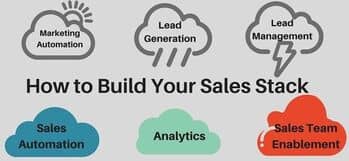
The reason I’m writing this post is because Lucep has started showing up in sales stacks in different categories – marketing automation, sales acceleration, lead distribution, sales team improvement, and even in the lead tracking and analytics sections. It shows how versatile our platform is in driving sales in different ways. In case you haven’t used Lucep, I’m going to show you how to build your sales stack, and use this opportunity to highlight all the places where we fit into the stack.
Step 1 is to know the categories of sales tools for each section of your funnel that can accelerate sales and drive growth.
Step 2 is to look at your sales process as a series of steps or stages in your funnel. Did you know that 60% of B2B companies lack a clearly defined sales process? Now’s as good a time as any to define your sales process. If you haven’t done it yet, there’s a free downloadable sales process template below that will help you.
Once you have your process in stages, map each stage against a sales tool category or subcategory. That will give you a better idea of what your final sales stack should look like.
Step 1 – Sales Tool and Technology Categories
The categories and subcategories below are listed in a way that you can see the flow from marketing automation to lead generation and management, and then sales automation. You also need tools to provide accurate analytics and forecasting, and sales team enablement tools to improve performance.
Category: Marketing Automation:
1. Website marketing tools
2. Email marketing tools
3. Social media marketing tools
4. Inbound marketing tools
Category: Lead Generation:
1. Sales intelligence
2. Sales prospecting tools
Category: Lead Management:
1. CRM
2. Lead scoring
3. Lead qualification
4. Lead distribution
Category: Sales Automation
1. Sales acceleration technology
2. Inside sales tools
3. Lead response
4. Lead nurturing
5. Customer support
6. Conversion rate optimization (CRO) tools
7. Sales & marketing alignment
Category: Analytics
1. Lead tracking
2. Traffic analytics
3. Sales forecasting>
Category: Sales Team Enablement
1. Hiring & training
2. Communication & collaboration platforms
3. Performance tracking
4. Sales team tracking
5. Gamification
Step 2 – B2B Sales Process Stages
I could list every single sales process stage in the funnel on a spreadsheet for you, but there’s no point in reinventing it when Hubspot and Insidesales.com have already done it so nicely. Visit this link and download their free sales process template.
Step 3 – Audit of Existing Sales Technology
1. Which stage in your sales process does it address?
2. What is the definition of success in this stage?
3. Is your sales team using this tool and all of its capabilities?
4. What is the ROI from the spend on this sales tool?
Include it in your sales stack if it is providing sufficient returns or at least has unfulfilled potential that you think can be tapped. Otherwise, replace it with a tool that has proven value in contributing to the success of that stage of the sales process.
Step 4 – Choosing the Right Sales Tools
The Lucep platform can handle (see see features and take the free signup) website marketing automation, sales acceleration, lead distribution and tracking. We also provide you with a weekly summary of sales team performance and website traffic analytics.
As for the rest, you need professional help from sales tools and technology experts:
Jakob Thusgaard – Sales stack that shows you a huge list of the tools you should be considering.
Sales technology expert Nancy Nardin – President and founder of Smart Selling Tools, Inc.